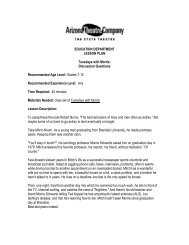Backwards in High Heels Arizona Theatre Company Play Guide
Backwards in High Heels Arizona Theatre Company Play Guide
Backwards in High Heels Arizona Theatre Company Play Guide
Create successful ePaper yourself
Turn your PDF publications into a flip-book with our unique Google optimized e-Paper software.
TIMELINE<br />
1926: The Savoy Ballroom opens <strong>in</strong> New York City. It<br />
will be a premiere dance venue throughout the next<br />
decades.<br />
1927: “Shorty George” Snowden co<strong>in</strong>s the term<br />
“L<strong>in</strong>dy Hop.” While watch<strong>in</strong>g a local dance contest<br />
at the Savoy, a reporter asks Snowden for the name<br />
of the dance be<strong>in</strong>g performed. He glances down at a<br />
newspaper headl<strong>in</strong>e about Charles L<strong>in</strong>dburgh which<br />
reads, “L<strong>in</strong>dy Hops the Atlantic,” and announces “The<br />
L<strong>in</strong>dy Hop!”<br />
The Savoy Ballroom<br />
1930s: The Jitterbug, a six-beat variant of the L<strong>in</strong>dy Hop, emerges. In time, the terms<br />
“sw<strong>in</strong>g,” “l<strong>in</strong>dy,” and “jitterbug” become <strong>in</strong>terchangeable.<br />
1935: Herbert White starts the dance group “Whitey’s L<strong>in</strong>dy Hoppers”, which grows to be<br />
wildly popular on the Savoy scene.<br />
1938: Innovative sw<strong>in</strong>g choreographer Dean Coll<strong>in</strong>s arrives <strong>in</strong> Hollywood. His work on<br />
over forty movies paves the way for the Hollywood dance musical.<br />
1940s: A “world dances” craze sweeps the ballroom realm. Dances that received new or<br />
revived attention <strong>in</strong>clude the Tango from Argent<strong>in</strong>a, the Samba from Brazil, the Paso Doble<br />
from Spa<strong>in</strong>, and the Waltz from Austria. The American Foxtrot rega<strong>in</strong>s popularity as well.<br />
Formal teach<strong>in</strong>g of l<strong>in</strong>dy, jitterbug, and sw<strong>in</strong>g beg<strong>in</strong>s.The Arthur Murray Dance Studio<br />
establishes the divide between “East Coast Sw<strong>in</strong>g” and “West Coast Sw<strong>in</strong>g”. Other sw<strong>in</strong>g<br />
variants that emerge <strong>in</strong>clude the Balboa, the Shag, and the Jive.<br />
The East-West Divide: In the 1940s, the Arthur Murray Dance Studio commissioned<br />
<strong>in</strong>structors around the country to study and teach the popular dances of their respective<br />
cities. This challenged dance teachers to “condense” the complex, <strong>in</strong>dividualized<br />
footwork of the regional sw<strong>in</strong>g dances <strong>in</strong>to simplifi ed forms for the general public. As a<br />
result, they co<strong>in</strong>ed the categories of sw<strong>in</strong>g that are familiar today. “East-Coast Sw<strong>in</strong>g”<br />
is a simple, 6-beat cycle that evolved from the L<strong>in</strong>dy Hop and the Foxtrot. “West-Coast<br />
Sw<strong>in</strong>g” is a more quick-footed variant that can have up to 8 counts and is danced <strong>in</strong> a<br />
smaller radius than its Eastern equivalent.<br />
-Written by Juliet Wilhelmi<br />
<strong>Backwards</strong> <strong>in</strong> <strong>High</strong> <strong>Heels</strong><br />
<strong>Arizona</strong> <strong>Theatre</strong> <strong>Company</strong> <strong>Play</strong> <strong>Guide</strong> 17



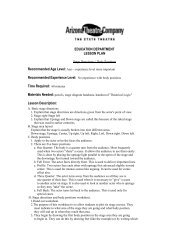



![Play Guide [356k PDF] - Arizona Theatre Company](https://img.yumpu.com/46218320/1/190x245/play-guide-356k-pdf-arizona-theatre-company.jpg?quality=85)
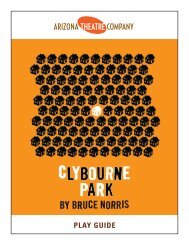
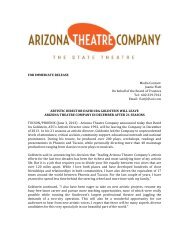
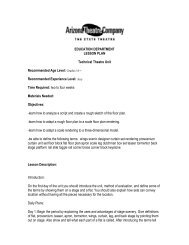
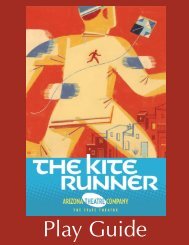
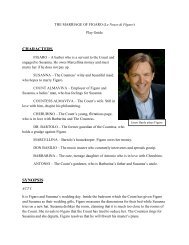
![[title of show] Arizona Theatre Company Play Guide 1](https://img.yumpu.com/24482689/1/190x245/title-of-show-arizona-theatre-company-play-guide-1.jpg?quality=85)
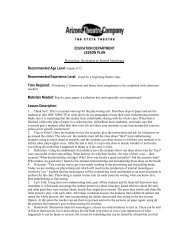
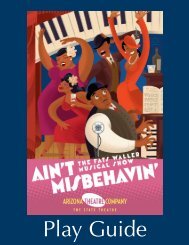
![Play Guide [1.2MB PDF] - Arizona Theatre Company](https://img.yumpu.com/11952176/1/190x245/play-guide-12mb-pdf-arizona-theatre-company.jpg?quality=85)
